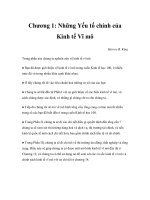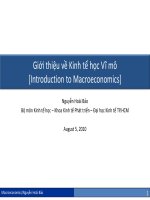KINH TẾ VI MÔ Chapter 1 introduction
Bạn đang xem bản rút gọn của tài liệu. Xem và tải ngay bản đầy đủ của tài liệu tại đây (411.44 KB, 33 trang )
PRINCIPLES OF
MICROECONOMICS
NGUYEN THI MINH THU
¢ Instructor:
¢ Office:
Nguyen Thi Minh Thu
Faculty of International
Nguyen Thi Minh Thu, FIE, FTU
Economics, 2nd floor, Building B.
¢ Email
address:
¢ Phone
number: 0902172177
2
TEXTBOOKS
¢ Mankiw,
Principles of Microeconomics (5th edition),
South Western CENGAGE Learning.
Nguyen Thi Minh Thu, FIE, FTU
¢ Krugman,
Wells, Microeconomics (3rd edition), Worth
Publishers.
¢ Pyndick,
Rubinfeld, Microeconomics (6th edition),
Pearson Education International.
3
4 DON’TS
¢ BE
LATE
Nguyen Thi Minh Thu, FIE, FTU
¢ CHAT
¢ SLEEP
¢ USE
PHONE
4
4 DOs
¢ Study
textbooks before class.
¢ Actively
¢ Do
Nguyen Thi Minh Thu, FIE, FTU
¢ Read
Applied Math
participate class activities
home works
5
TOPICS IN MICROECONOMICS
ü
ü
ü
ü
ü
NGUYEN Thi Minh Thu, FIE
ü
Introduction to Microeconomics
Demand and Supply
Consumer Behavior
Producer Behavior
Market Structures
Labor Market
6
QUESTION
¢ Suppose
Nguyen Thi Minh Thu, FIE, FTU
that you and your friends is going to
hold a junior prom.
¢ 100 students is going to attend for sure
¢ According to your calculation, each will have to
pay 200,000 VND to cover payment for food
(150,000 VND each) and music band as well as
the hall.
¢ One hour before the prom, one classmate says he
wants to attend but just has 180,000 VND.
¢ What is your decision?
7
CHAPTER 1: PRELIMINARIES
THEMES OF MICROECONOMICS
2.
ANALYSIS METHODS
3.
WHY STUDY MICROECONOMICS
Nguyen Thi Minh Thu, FIE, FTU
1.
8
THEMES OF MICROECONOMICS
Nguyen Thi Minh Thu, FIE, FTU
9
THEMES OF MICROECONOMICS
¢
An economy consists of at least 3 kinds of
Households,
Firms,
Government.
¢ Households:
Consumers & Owners of
production factors
¢ Firms:
factors
Nguyen Thi Minh Thu, FIE, FTU
agents:
Producers & Users of production
10
THEMES OF MICROECONOMICS
¢ Two
types of markets: Market for
commodities.
¢ Should
Firms always be sellers?
Nguyen Thi Minh Thu, FIE, FTU
production factor and Market for
11
THEMES OF MICROECONOMICS
¢ Can
firms always produce whatever they want to
¢ Can
consumers always get goods and services
that they desire?
¢ Can
Government always satisfy society s needs?
Nguyen Thi Minh Thu, FIE, FTU
produce?
è The problem of scarcity
12
THEMES OF MICROECONOMICS
¢ Scarcity
is the state of being short of
unlimited wants)
è Economics is the study how society
deals with scarcity.
¢ Two
Nguyen Thi Minh Thu, FIE, FTU
resources (limited resources vs.
major branches: Microeconomics
and Macroeconomics
13
THEMES OF MICRECONOMICS
is a branch of
economics that deals with the behavior
of these individual economic units as
well as the markets that these units
Nguyen Thi Minh Thu, FIE, FTU
è M icroeconomics
comprise.
14
THEMES OF MICRECONOMICS
branch of economics that deals with
aggregate economic variables, such as the
level and
growth rate of national output,
interest rates, unemployment,
inflation.
Nguyen Thi Minh Thu, FIE, FTU
On the other hand, macroeconomics is a
and
15
THEMES OF MICROECONOMICS
Microeconomics describes how prices are determined.
are set by the government.
- In a market economy, prices are determined by the
interactions of consumers and firms. These interactions
occur in markets—collections of buyers and sellers that
Nguyen Thi Minh Thu, FIE, FTU
- In a centrally planned/command economy, prices
together determine the price of a good.
16
17
ANALYSIS METHODS OF
MICROECONOMICS
¢ Marginal
thinking
Nguyen Thi Minh Thu, FIE, FTU
¢ Modeling
18
MODELING
¢ An
economic model is a simplified representation
¢ Basic
assumption: Ceteris Paribus
¢ Others:
Prefer more to less, perfect information,
etc.
¢ Assumed
goals
-
Consumers: Utility maximization
-
Producers: Profit maximization
-
Government: Efficiency vs. Equality
Nguyen Thi Minh Thu, FIE, FTU
of reality explaining how the economy works.
19
THE ECONOMY
Nguyen Thi Minh Thu, FIE, FTU
20
MARGINAL THINKING
¢ Rational
Nguyen Thi Minh Thu, FIE, FTU
people think at the margin
¢ Cost – Benefit analysis
21
EXAMPLE
¢ Suppose
500,000 VND
c. 100,000 VND
a.
Nguyen Thi Minh Thu, FIE, FTU
you are given a free ticket of Quang
Dung live concert.
¢ At the same time, Dam Vinh Hung also holds a
show, for which you are willing to pay 500,000
VND. The market price for DVH show ticket is
400,000 VND.
¢ If you choose QD, do you incur any cost?
b. 400,000 VND
d. 0 VND
22
MARGINAL THINKING
¢ Total
cost includes opportunity cost
cost is the value of the
second best option that you forgo.
Nguyen Thi Minh Thu, FIE, FTU
¢ Opportunity
23
MARGINAL THINKING
¢ Total
benefit is the money value of
¢ Net
benefit is the difference
between total benefit and total cost.
¢ NB
Nguyen Thi Minh Thu, FIE, FTU
what you gain.
= TB – TC
24
MARGINAL THINKING
¢ Marginal
cost is the change in total cost resulting
¢ If
ΔTC
MC =
ΔQ
the total cost is continuous
Nguyen Thi Minh Thu, FIE, FTU
from the production of an extra unit of product.
MC = TC (Q)
25
€









